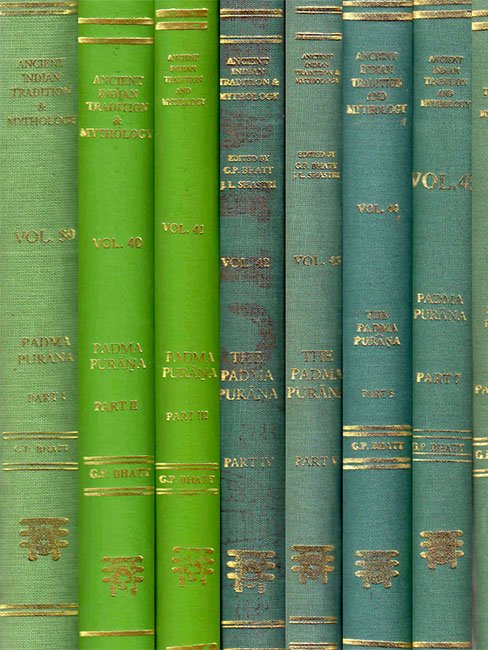The Skanda Purana
by G. V. Tagare | 1950 | 2,545,880 words
This page describes The Glory of Someshvara (Soma-ishvara) which is chapter 8 of the English translation of the Skanda Purana, the largest of the eighteen Mahapuranas, preserving the ancient Indian society and Hindu traditions in an encyclopedic format, detailling on topics such as dharma (virtous lifestyle), cosmogony (creation of the universe), mythology (itihasa), genealogy (vamsha) etc. This is the eighth chapter of the Prabhasa-kshetra-mahatmya of the Prabhasa Khanda of the Skanda Purana.
Chapter 8 - The Glory of Someśvara (Soma-īśvara)
[Sanskrit text for this chapter is available]
The Devī said:
1. Once more, do tell me the greatness of Śrīsomeśvaradeva, O Lord of Devas, O benefactor of the worlds. It is destructive of all sins. Tell me the trinity (Liṅga) that has Brahmā, Viṣṇu or Śiva as well as all the three as deities.
Īśvara said:
2-3. Listen with single-minded attention to my ancient lore that should be guarded as a secret. Listen to the great miracle that happened in that Liṅga.
Like an oblation (Āhuti) of clarified butter into sacred fire, sixty thousand crores of sages of sublimated sexuality entered that Liṅga.
4. These Śaktis also originated therefrom: Siddhi (Achievement), Vṛddhi (Enhancement), Tuṣṭi (Satisfaction), Ṛddhi (Prosperity), Puṣṭi (Nourishment), the fifth one, Kīrti (Reputation), Śānti (Quiescence) and Lakṣmī (Fortune). All these rose up from that Liṅga.
5-6. Seven crores of Mantras and Siddhis, Divine Yogas and Rasas (essences, elixir), divine medicines and potions, Bhūtatantra pertaining to Garuḍa, Khecarīs (sky-stalkers, evil spirits) and Vyantarīs (spirits)—all these originated together from that Liṅga.
7. The other eight Siddhis (e.g. Aṇimā, Laghimā etc.) also that have been glorified, rose up from that spot along with the Liṅga.
8. O goddess, I shall mention another thing. Those who attained Siddhi here and were born as parts of mine were merged in this Liṅga.
9-10. I shall mention their exploits in due order. The following seven are remembered as Kutsikas: Purākramas, Grahas, Muṇḍas, Guḍakas, Hetukas, Vimalas and Daṇḍikas. Through my Pāśupata yoga, these achieved Siddhi in this Liṅga formerly.
11. The following seven are glorified as Gārgeyas: Rudra, Vipra, Dāna, Candra, Mantha, Avalokaka and Sūryāvaloka.
12-13. O lady of excellent complexion, they become Siddhas in Someśvara at Prabhāsa. The following are glorified as Pauruṣeyas: Mūkammanya, Śiva, Prakāśa, Kapila, Satkula and Karṇikāra. Formerly they became Siddhas in Someśvara at Prabhāsa that is destructive of sins.
14. In every Yuga formerly there appeared Siddhas in that favourite Liṅga of mine. These and other Brāhmaṇas will be born in Kali Yuga.
15. There they will attain Siddhi that is inaccessible even to Devas. Thus that Liṅga which bestows excellent Siddhis has been wholly explained to you.
16. It is difficult of access to all human beings. It is well-established in Prabhāsa. No one who is engaged in inauspicious activities understands it.
17-21. All the (following) malefic evil spirits and ailments perish when one visits Someśvara Liṅga, like fuel consigned to fire. The malefic spirits etc. are as follows: troubles caused by Bhūtadoṣas, Ḍākinīs, Pretas, Vetālas, Rākṣasas, Graha, Pūtanas, Piśācas, Yātudhānas, mothers called Jātahārikās (those who snatch away the new-born ones), Bālagrahas, and Buddha Grahas. The evil spirits of ailments are: Jvarabhūtagrahas, Atisāras (diarrhoea), Bhagandaras (fistula), Aśmarī (stones), Mūtrakṛcchra (strangury), and thousands of other ailments such as ulcers, leprosy, tuberculosis, rheumatism, gout, piles etc.
22. All other torments from serpents, scorpions, Ghoṇapas (insects drinking through snouts, i.e., hogs etc.)—all these perish by visiting Someśvara.
23-24. The last Bhairava is remembered by the name Someśvara. He is well-known by the synonyms of Kālāgni, Rudranātha etc. I stand thereon, O goddess of Devas, conferring blessings on devotees. Undoubtedly I devour all the evil deeds of men.
25. The Prāṇa (vital breath) present in the body, that moves about in the bodies of living beings, is one in the whole of the Cosmic Egg and also in diverse forms.
26-27. All the Vedas and the great sages praise this Lord. The form of the great Brahman is attained through that deity and that Lord is established in Prabhāsa. It is like a well concealed gem in the house which no one knows.
28. That Liṅga is stationed in Prabhāsa. It is like a gem. In the former Kalpa it pierced through the seven Pātālas.
29. It is mentioned as resembling the refulgence of a crore of suns and the fire at the time of annihilation. Therefore Someśvara is mentioned as Kālāgni Rudra.
30. Thus, O goddess Pārvatī, the greatness of Someśvara has been briefly described to you. It is destructive of all sins.
